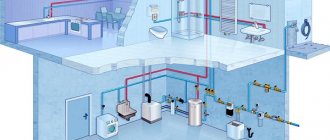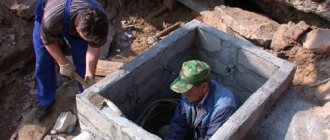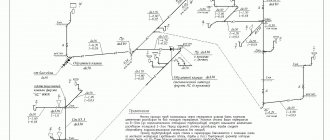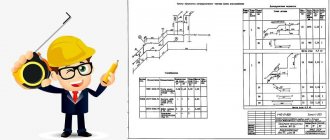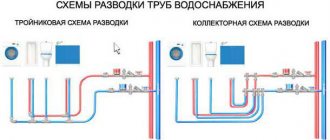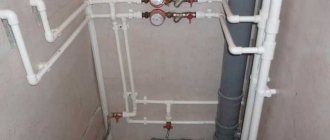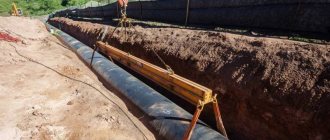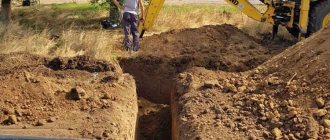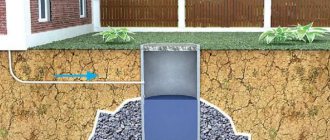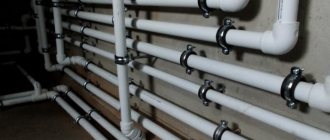Providing public, industrial, residential and administrative buildings with cold and hot water supply, as well as the arrangement of sewage systems, is a primary task for creating a comfortable environment for work and life.
Providing public, industrial, residential and administrative buildings with cold and hot water supply, as well as the arrangement of sewage systems, is a primary task for creating a comfortable environment for work and life. Without water and drainage, there is no way to fulfill utilitarian needs and meet the needs of production, educational and other processes.
Installation of an external sewerage system and water supply is included in the building's engineering networks during the construction phase. Based on the location of the pipeline, water supply and sewerage networks are divided into internal and external. The functionality and durability of engineering systems depends on the quality of design and installation of pipes, risers, treatment facilities, pumping stations and other equipment. In St. Petersburg, the full range of work on the design and installation of water supply networks is carried out by certified specialists.
Features of water supply and sanitation systems in apartments and residential buildings
There are two important points that should be taken into account when planning and designing engineering systems:
- External water supply and sewerage systems are installed during the construction of the building. If you start installing pipes after the finishing is completed, when laying water pipes, sewer drains, installing fasteners and other related work, you will have to disrupt the integrity of the appearance of the building. In addition, installation of engineering systems in a fully constructed building requires additional resources: materials, time, money.
- Engineering water supply and sanitation systems are directly dependent on each other. It is impossible to install only pipes for supplying water to the building, without ensuring drainage. In this case, the water supply can be centralized, and the sewage system local (septic tank, drainage pit), or vice versa. The key is to ensure that the networks are coherent, taking into account their interdependencies.
When drawing up design documentation for external water supply and sewerage systems, it is necessary to adhere to the standards approved by current regulatory documents:
- GOST 21-101-97 “Basic requirements for design and working documentation.”
- SNiP 2.04.02-84 “Water supply. External networks and structures.”
- SNiP 2.04.03-85 “Sewerage. External networks and structures.”
- SNiP 3.05.04-85 “External networks and structures of water supply and sewerage.”
- SP 40-102-2000, SP 40-104-2001 Design and installation of pipelines made of polymer materials and fiberglass pipes.
- GESN-2001-22 “Water supply. External networks".
Technical designs of engineering systems are developed for buildings that are to be constructed in the next 2–3 years.
Stages of water supply project development:
- Select a source of water supply, taking into account the volume of water consumption of the building and other technical nuances. The source can be a well located on a plot of land near a private house, or a centralized water supply from a city water utility.
- Develop a scheme for laying sewer pipes taking into account the upcoming excavation work, calculate the optimal location of sanitary and hygienic fixtures (sinks, toilets, showers, bathtubs, drinking fountains)
- Calculate an estimate for the work.
The sewer project is carried out similarly. First you need to determine where the wastewater will be discharged. Next, they develop a pipeline diagram and select the equipment necessary to ensure uninterrupted operation of the sewerage system. Design is carried out in two stages: design assignment with estimates and working drawings.
Installation of external networks - prices
| Installation of a water supply point | PC. | 1 | 1100 rub. |
| Installation of heated towel rail point | PC. | 1 | 2500 rub. |
| Laying sunbeds and water supply risers with insulation | PC. | 1 | 12000 rub. |
| Installation of the recirculation route | PC. | 1 | 6000 rub. |
| Installation of distribution manifold | PC. | 1 | 2500 rub. |
| Installation of a drain pipe | PC. | 1 | 2000 rub. |
Water pipes
Based on their purpose, basic engineering water supply systems are divided into three types:
- Household systems. Purpose - to provide household and drinking needs (cooking, washing and disinfection, hygiene procedures).
- Production systems. It is used to supply water necessary for technical processes (cooling equipment, powering heating boilers).
- Fire protection systems. They are used for external and internal fire extinguishing in buildings, to prevent fires and fire hazardous situations.
Another type of plumbing system that is found in buildings is a sprinkler network. It supplies water for watering paths and caring for flowering plants and green spaces.
The household drinking water supply system must ensure the supply of high quality water. The domestic water supply system consists of the following elements:
- Water supply inlet is a section of pipeline laid underground, passing from the well to the outer wall of the building. There is a shut-off valve at the pipeline inlet.
- Metering unit - meter, pressure gauge, shut-off valves.
- Pipeline layout with risers.
- Water handling equipment.
- Installations for increasing pressure in the system.
- Treatment facilities, filtering equipment.
The industrial water supply system is designed to supply process water. Requirements for water quality depend on the characteristics of technological processes. Most often, industrial water supply supplies water to the boiler room and to the cooling units of ventilation and air conditioning systems.
There are two types of fire water supply networks:
- Low pressure systems. Water for hydrants is pumped into the network by autopumps from a centralized water supply.
- High pressure systems. They provide water pressure sufficient for fire extinguishing directly from the hydrant. A more expensive and technically complex option.
If the internal water pressure in the network is not enough for the fire extinguishing system, it is necessary to install additional motor pumps of appropriate power.
Pipe selection
Red polymer pipes are produced for external sewerage
Cast iron and asbestos cement are heavy, so it is difficult to lay sewerage from such pipes yourself. Polyvinyl chloride is very popular when constructing an internal drainage system - it is a lightweight, convenient and non-toxic material. However, it is not suitable for the outside - during severe frosts the risk of cracking the walls increases.
Polypropylene has the following advantages:
- high resistance to low temperatures;
- chemical inertness;
- low weight of products;
- high mechanical strength;
- no corrosion;
- long service life;
- low roughness coefficient.
Polyethylene pipes have a significant advantage - they do not burst even when completely frozen. In addition, these products can withstand wastewater temperatures up to 95 degrees and are resistant to aggressive chemicals. The service life of polyethylene products is 40 years or more.
Features of pipe selection:
- Polypropylene products must be smooth.
- When choosing polyethylene, it is better to purchase corrugated elements. They are better suited for constructing an underground highway because they cope well with high mechanical pressure (for example, if they are laid under an asphalt path).
Plastic products are easier to install, but when choosing them, you need to take into account the operating conditions: depth of location, presence of a passage area above the pipes.
Hot water supply and heating
There are two options for organizing hot water supply and water heating - connect the building to a centralized source or heat the water on site using your own boiler room. The choice of option depends on the needs and technical feasibility. Features of centralized hot water supply:
- For multi-storey buildings, centralized water supply is more profitable and convenient. Less costs are spent on network development. It is enough to lay out the pipes and install distribution equipment and shut-off valves. In addition, according to SNiP standards, there are restrictions on the installation of boiler equipment in buildings above 5 floors.
- There is no possibility to locally control the supply of hot water to the water supply and heating system. If an accident occurs in a city boiler room, the building is left without hot water supply until it is repaired.
- Hot water tariffs are set by the supplier.
The advantages of decentralized water heating for the needs of the building in its own boiler room:
- The hot water supply and heating are turned on and off by the user or his representative directly in the building. This allows you to save money and use resources optimally.
- You can regulate the temperature in each individual room using shut-off valves.
Local hot water supply and heating systems have their drawbacks. Boiler equipment is an additional expense item. Often a separate room is required for its installation. The technical condition of the equipment must be monitored by users or technical personnel, whose salaries are paid by consumers of water and heat. Responsibility for compliance with safety rules falls on the users or on the management company that ensures the functioning of the building's engineering systems.
Metal pipelines
Most often, the main water supply pipeline network is installed from steel pipes. And since they are susceptible to corrosion and often have mechanical defects, they are subject to fairly strict requirements.
Steel
The pipes must be inspected before installation. The most important criteria that must be assessed when accepting steel pipes are: straightness, absence of damage to the insulating layer, and absence of dents in the middle.
If the end of the tube is deformed, you can simply cut it off. The ends of the pipes must be smooth, without nicks or burrs.
Pipe connection options
All known connection methods are suitable for assembling steel pipes, but welding is considered the most reliable. When using this method, the pipes must be joined using a centralizer.
Before starting assembly, they should be cleaned and the geometry of the edges checked. The edges themselves, as well as the adjacent inner and outer surface of about 10 mm, must be polished to a shine.
The welding method is determined in the project. If pipes with factory insulation are used to assemble the water supply system, then after welding it must be restored. During installation, pipes with one longitudinal or spiral seam should be laid with the seams offset by 10 cm. If there are seams on both sides, then they do not need to be displaced.
Pipe centralizer
Edge processing of steel pipes
Pipe cutter for small diameter steel pipes
Factory insulation of water supply pipelines
So:
- If the transverse connection is welded, then it should not be located closer than 30 cm to the wall of the well, or 20 cm to the ground support. When a pipe is welded to a pipe, the distance from this seam to the circumferential seam of the pipeline must be at least 100 mm. The quality of welding at joints is necessarily subjected to physical control methods, which is reflected in the work log and confirmed by a certificate.
- When installing pipelines, the greatest responsibility lies with welders, so not all of them may be allowed to install pipelines. Even if the welder has the necessary qualifications, but he has no experience, or he has had a break in his specialty for more than six months, and also in cases where new equipment, materials, steel grades, etc. are used, he has to pass a kind of exam .
- A person must weld a joint, which is called a tolerance joint, under the real conditions of the object. It is inspected visually, tested for tearing and bending, and only if the result is satisfactory, the welder will be allowed to work. If something doesn’t work out, he is given two more tries. And if they also turned out to be unsuccessful, at best, he is sent for additional training.
Welders installing a pipeline
Each specialist is assigned a mark, and the welder who made the connection is obliged to affix it 3-5 cm from each joint. The quality of a weld is considered normal if there are no cracks, deviations from shape and size, sagging, lack of penetration, burns, undercuts or displacements of welded edges in it and the adjacent area.
Cast iron
Most often, drainage systems are installed from cast iron pipes, but sometimes water supply pipelines are also assembled from them. Since cast iron is a rather fragile material, first of all, when accepting pipes, they are checked for cracks by tapping.
They must have a smooth surface, free of slag inclusions. The maximum that is allowed is shells with a diameter of no more than 1 cm and a depth of up to 3 mm.
Most often, cast iron pipes have a socket and are used for assembling non-pressure systems. Before installation, the sockets must be cleaned from burnt sand or oils and burrs are removed.
One of the options for joining cast iron pipes
Installation of such pipes can be carried out: using the supplied silicone or rubber cuffs; using sealant; with a lock made of asbestos-cement or cement mixture. Its composition, as well as the type of sealant, determines the project.
Otherwise, the installation of cast iron pipes is carried out similarly to steel pipes. The video in this article will show you this process clearly.
Painting of water supply pipelines
If metal pipes do not have a factory protective layer, then during installation work, in order to protect the metal from corrosion, the pipeline is painted. Only copper pipes do not need anti-corrosion treatment, but due to their high cost, they are not used for the installation of centralized networks.
However, if you want to install an autonomous water supply system with water supplied from a well (see Water supply from a well: how to do it yourself), and do not experience budget constraints, nothing prevents you from using copper pipes. Water from such a system will not only be cleaner, but also useful, since in this case it (by analogy with silver) is saturated with copper ions.
